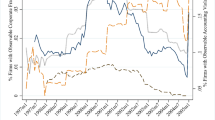Abstract
In recent times, the number of dumping actions has shown a striking correlation with the respective level of economic activity.1 The following observations convey an overall picture of the dumping actions currently pending and the anti-dumping measures implemented, and look into the current problems faced by the international anti-dumping system.
Similar content being viewed by others
References
Cf. S. P. Magee: Protectionism in the United States, University of Texas at Austin 1982 (mimeo), quoted from B. S. Frey: The public choice view of international political economy, in: International Organization 38 (1984) 1, p. 211.
At the beginning of 1982 in the USA, there were in total 93 actions being brought by American steel firms for allegedly dumped or subsidised steel imports. Cf. US mission Geneva, Daily Bulletin No. 33 of 19. 2. 1982, p. 1.
US Department of State: Proposals for Expansion of World Trade and Employment, November 1945, Publication 2411, C: III, Sec.A:3.
US Department of State: Suggested Charter for an International Trade Organization of the United Nations, September 1946, Publication 2598, Art. 11.
US Department of State: Havana Charter for an International Trade Organization, 24. 3. 1948, Publication 3206, Art. 34.
US Revenue Act of 1916, §801, 39 Stat. 798 (1916).
US, Anti-dumping Act of 1921; Tariff Act of 1930.
US, Public Law 96-39 of 26. 7. 1979 (Trade Agreements Act of 1979), Section 773(b).
The observations on the creation of the GATT Dumping Provisions are based on, among others, John H. Jackson: World Trade and the Law of GATT, Indianapolis, Kansas City, New York 1969, p. 404 ff.
GATT, Art. VI:6(a).
GATT, Art. VI:6(c).
“Agreement on Implementation of Article VI of the GATT”, in: GATT, BISD 15th S (1968), p. 24 ff.
“Agreement on Interpretation and Application of Articles VI, XVI and XXIII”, in: GATT, BISD 26th S (1980), p. 56.
Cf. GATT: The Tokyo Round of Multilateral Trade Negotiations, Geneva 1979, p. 181; GATT: The Tokyo Round of Multilateral Trade Negotiations II—Supplementary Report, Geneva 1980, p. 10.
“Agreement on Implementation of Article VI”, in: GATT, BISD 26th S (1980), p. 171.
GATT, Art. VI:1.
GATT, Art. VI:4.
“Whenever the administering authority has reasonable grounds to believe or suspect that sales in the home market of the country of exportation…have been made at prices which represent less than the cost of producing the merchandise in question…” US, Public Law 96-39 of 26. 7. 1979 (Trade Agreements Act of 1979), Sec. 773(b)).
Cf. on this point of controversy Kiyoshi Kawahito: Steel and the U.S. Antidumping Statutes, in: Journal of World Trade Law 16 (1982) 2, p. 153 ff.
GATT, Art. VI:1(b)ii.
GATT, Anti-dumping Code, Art. 2:4.
US Department of State: Suggested Charter for an International Trade Organization of the United Nations, September 1946, Publication 2598, Art. 11:1.
US Department of State: Havana Charter for an International Trade Organization, 24. 3. 1948, Publication 3206, Art. 34:1(a).
GATT, Anti-dumping Code, Art. 2:2.
GATT, BISD 8th S (1960), p. 146.
GATT, Anti-dumping Code, Art. 2:6.
GATT, Anti-dumping Code, Art. 3:1.
US Mission Geneva, Daily Bulletin No. 33 of 19. 2. 1982, p. 1 f.
GATT, Anti-dumping Code, Art. 3:2.
Neue Zürcher Zeitung of 13. 7. 1982, No. 159, p. 11.
US Mission Geneva, Daily Bulletin, No. 33, of 19. 2. 1982, p. 2.
GATT, Anti-dumping Code, Art. 3:6 and 7.
GATT, Anti-dumping Code, Art. 4:1.
GATT, Anti-dumping Code, Art. 4:3.
Apart from one exception in 1954 (action taken by Italy against Sweden (GATT, BISD 3rd S (1955), p. 81 ff.)) GATT has seen no disputes in this connection up to the present time.
R. Senti: Subventionen in der geltenden Welthandelsordnung, in: Außenwirtschaft 38 (1983) I, p. 21 ff.
GATT, Anti-dumping Code, Art. 5:1.
GATT, Anti-dumping Code, Art. 10:1.
GATT, Anti-dumping Code, Art. 7.
GATT, Anti-dumping Code, Art. 8:1.
GATT, Anti-dumping Code, Art. 12.
Cf. Kenneth W. Dam: The GATT, Law and International Economic Organization, Chicago, London 1970, p. 167 ff; Kiyoshi Kawahito, op. cit. Steel and the U.S. Antidumping Statutes, in: Journal of World Trade Law 16 (1982) 2, p. 157 ff.
Kenneth W. Dam, op. cit.: The GATT, Law and International Economic Organization, Chicago, London 1970, p. 167 ff; p. 168.
Cf. Kiyoshi Kawahito, op. cit. Steel and the U.S. Antidumping States, in: Journal of World Trade Law 16 (1982), 2, p. 157 Following in the vein of this argumentation, Kiyoshi Kawahito says with reference to the US/EEC steel war: “It is irrational for the United States to expect foreign producers to adopt a pricing policy which is neither approved by economic theories nor practiced by American business firms.”
Author information
Authors and Affiliations
Rights and permissions
About this article
Cite this article
Senti, R. Dumping and anti-dumping measures. Intereconomics 19, 187–193 (1984). https://doi.org/10.1007/BF02928334
Issue Date:
DOI: https://doi.org/10.1007/BF02928334




